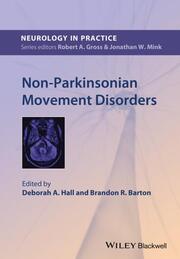Detailansicht
Non-Parkinsonian Movement Disorders
NIP- Neurology in Practice
ISBN/EAN: 9781118473924
Umbreit-Nr.: 9834770
Sprache:
Englisch
Umfang: 224 S.
Format in cm:
Einband:
kartoniertes Buch
Erschienen am 17.02.2017
Auflage: 1/2017
- Zusatztext
- A clinical 'in the office' or 'at the bedside' guide to effective patient care for neurologists in practice and in training * Each presentation includes practical descriptions of phenomenology, and key clinical information from the history and neurological examination that guide the physician to the correct diagnosis, and treatment options * Throughout the book Science Revisited highlights remind clinicians of the scientific anchors related to each disorder, and Evidence at a Glance boxes summarise clinical trial evidence-based review information * Numerous video clips in every chapter demonstrate different movement disorders to aid diagnosis * Unique learning tools, Tips and Tricks and Caution Warning boxes, give useful hints on improving outcomes and preventing errors
- Kurztext
- Describing and differentiating the different tics, jerks, spams and tremors that present as movement disorders is frequently less than straightforward. Formulating a differential diagnosis to account for these movements, and to develop a treatment plan, is a further challenge. NonParkinsonian Movement Disorders provides the tool kit you need to effectively identify the movement disorders your patients suffer. Starting from the various movement phenomena patients present with, and using clinically proven approaches, the stellar cast of authors provide a practical guide to diagnosis and management. Clearly divided into sections, the first section of this book contains a short chapter on non-parkinsonian hypokinetic movement disorders (parkinsonian disorders are covered in another volume in the Neurology in Practice Series), and the second section discusses hyperkinetic disorders. Section three covers various syndromes that do not fit into the other categories or that overlap between categories, and finally broader chapters on genetics, neuroimaging, rating scales, and videotaping suggestions serve as resources to the reader. * Each presentation includes practical descriptions of phenomenology, and key clinical information from the history and neurological examination that guide the physician to the correct diagnosis, and treatment options * Throughout the book Science Revisited highlights remind clinicians of the scientific anchors related to each disorder, and Evidence at a Glance boxes summarise clinical trial evidence-based review information * Numerous video clips in every chapter demonstrate different movement disorders to aid diagnosis * Unique learning tools, Tips and Tricks and Caution Warning boxes, give useful hints on improving outcomes and preventing errors Clinical in approach, practical in execution, Non-Parkinsonian Movement Disorders helps you better help your patients.
- Autorenportrait
- Deborah Hall, MD, PhD Department of Neurological Sciences, Section of Movement Disorders at Rush University Medical Center, Chicago Dr Hall was awarded her MD at Indiana University and completed her internship, neurology residency and movement disorders fellowship at University of Colorado. She is the recipient of an NIH K23 career development award to investigate the prevalence of FMR1 repeat expansions in various movement disorders. Her research interests are in Fragile X tremor ataxia syndrome and in clinical aspects of movement disorders. Brandon Barton, MD Department of Neurological sciences, Rush University Medical Center, Chicago Dr Barton splits his time between the Movement Disorders section at Rush University Medical Center and the Veterans Administration. Barton's research interests are in clinical trials in movement disorders, and in behavioral changes in Parkinson disease, particularly impulse control disorders.
